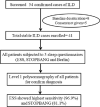Role of sleep questionnaires in predicting obstructive sleep apnea amongst interstitial lung diseases patients
- PMID: 37417085
- PMCID: PMC10401977
- DOI: 10.4103/lungindia.lungindia_731_21
Role of sleep questionnaires in predicting obstructive sleep apnea amongst interstitial lung diseases patients
Abstract
Introduction: The co-existence of obstructive sleep apnea (OSA) and interstitial lung diseases (ILD) results in significant morbidity and mortality. So screening for OSA is important for its early diagnosis among ILD patients. The commonly used questionnaires for screening of OSA are Epworth sleep score (ESS) and STOP-BANG. However, the validity of these questionnaires among ILD patients is not well studied. The aim of this study was to assess the utility of these sleep questionnaires in detection of OSA among ILD patients.
Methods: It was a prospective observational study of one year in a tertiary chest centre in India. We enrolled 41 stable cases of ILD who were subjected to self-reported questionnaires (ESS, STOP-BANG, and Berlin questionnaire). The diagnosis of OSA was done by Level 1 polysomnography. The correlation analysis was done between the sleep questionnaires and AHI. The sensitivity, specificity, positive predictive value (PPV), and negative predictive value (NPV) were calculated for all the questionnaires. The cutoff values of STOPBANG and ESS questionnaire were calculated from the ROC analyses. P value of <0.05 was considered to be significant.
Results: OSA was diagnosed in 32 (78%) patients with mean AHI of 21.8 ± 17.6.The mean age was 54.8 ± 8.9 years with majority being female (78%) and mean body mass index (BMI) was 29.7 ± 6.4 kg/m2. The mean ESS and STOPBANG score were 9.2 ± 5.4 and 4.3 ± 1.8, respectively, and 41% patients showed high risk for OSA with Berlin questionnaire. The sensitivity for detection of OSA was highest (96.1%) with ESS and lowest with Berlin questionnaire (40.6%). The receiver operating characteristics (ROC) area under curve for ESS was 0.929 with optimum cutoff point of 4, sensitivity of 96.9%, and specificity of 55.6%, while ROC area under curve for STOPBANG was 0.918 with optimum cutoff point of 3, sensitivity of 81.2% and specificity of 88.9%.The combination of two questionnaires showed sensitivity of >90%. The sensitivity also increased with the increasing severity of OSA. AHI showed positive correlation with ESS (r = 0.618, P < 0.001) and STOPBANG (r = 0.770, P < 0.001).
Conclusion: The ESS and STOPBANG showed high sensitivity with positive correlation for prediction of OSA in ILD patients. These questionnaires can be used to prioritize the patients for polysomnography (PSG) among ILD patients with suspicion of OSA.
Keywords: ESS and STOPBANG; ILD; OSA; questionnaires.
Conflict of interest statement
There are no conflicts of interest.
Figures



Similar articles
-
Improving OSA screening efficiency with subjective questionnaires: integrating STOP-Bang, ESS, and Berlin.Front Med (Lausanne). 2025 Jul 2;12:1581904. doi: 10.3389/fmed.2025.1581904. eCollection 2025. Front Med (Lausanne). 2025. PMID: 40672817 Free PMC article.
-
Application value of joint STOP-Bang questionnaire and Epworth Sleepiness Scale in screening for obstructive sleep apnea.Front Public Health. 2022 Sep 29;10:950585. doi: 10.3389/fpubh.2022.950585. eCollection 2022. Front Public Health. 2022. PMID: 36267990 Free PMC article.
-
The Screening Value Of ESS, SACS, BQ, And SBQ On Obstructive Sleep Apnea In Patients With Chronic Obstructive Pulmonary Disease.Int J Chron Obstruct Pulmon Dis. 2019 Nov 13;14:2497-2505. doi: 10.2147/COPD.S223354. eCollection 2019. Int J Chron Obstruct Pulmon Dis. 2019. PMID: 32009782 Free PMC article.
-
Diagnostic accuracy of the Berlin questionnaire, STOP-BANG, STOP, and Epworth sleepiness scale in detecting obstructive sleep apnea: A bivariate meta-analysis.Sleep Med Rev. 2017 Dec;36:57-70. doi: 10.1016/j.smrv.2016.10.004. Epub 2016 Nov 5. Sleep Med Rev. 2017. PMID: 27919588 Review.
-
Diagnostic utility of obstructive sleep apnea screening questionnaires: a comprehensive meta-analysis.Sleep Breath. 2024 Nov 27;29(1):14. doi: 10.1007/s11325-024-03169-z. Sleep Breath. 2024. PMID: 39601864 Review.
References
-
- Pien GW, Rosen IM, Fields BG. Sleep apnea syndromes:Central and obstructive. In: Grippi MA, editor. Fishman's Textbook of Pulmonary Disease and Disorders. New York: McGraw Hill Medicine; 2015. pp. 3042–3.
-
- Udwadia AF, Doshi AV, Lonkar SG, Singh CI. Prevalence of sleep-disordered breathing and sleep apnea in middle-aged urban Indian men. Am J Respir Crit Care Med. 2004;169:168–73. - PubMed
-
- Sharma SK, Ahluwalia G. Epidemiology of adult obstructive sleep apnoea syndrome in India. Indian J Med Res. 2010;131:171–5. - PubMed
-
- Young T, Evans L, Finn L, Palta M. Estimation of the clinically diagnosed proportion of sleep apnea syndrome in middle-aged men and women. Sleep. 1997;20:705–6. - PubMed
LinkOut - more resources
Full Text Sources

